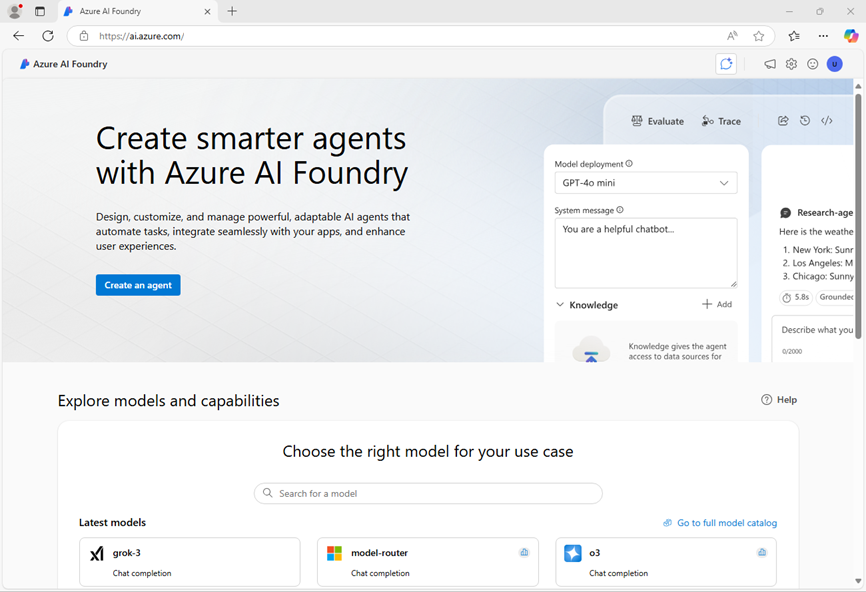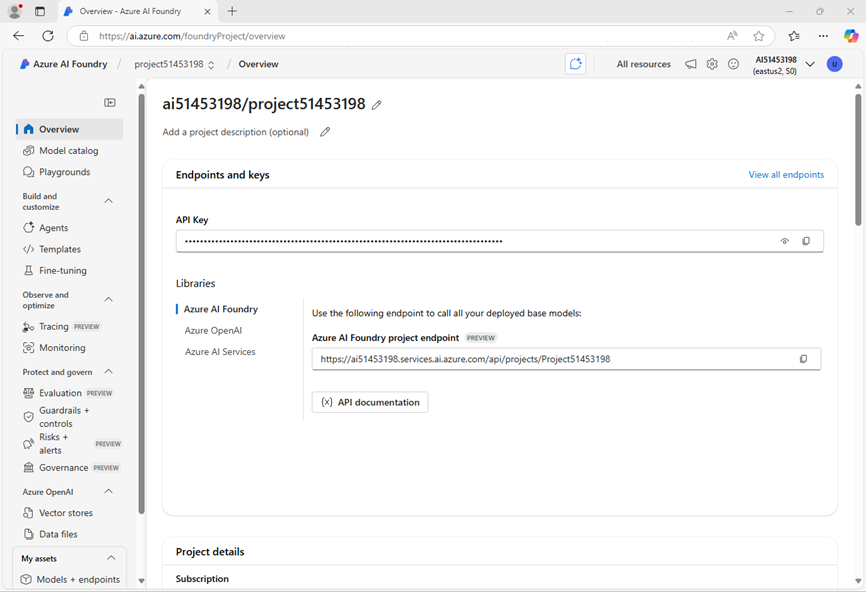mslearn-ai-semantic-kernel
Apply filters on functions
In this exercise, you consume a previous chat conversation between the user and the assistant to generate a new response. To do this, you need to apply a trust filter on the function result. Let’s get started!
This exercise takes approximately 10 minutes to complete.
Deploy a chat completion model
-
In a web browser, open the Azure AI Foundry portal at
https://ai.azure.comand sign in using your Azure credentials. Close any tips or quick start panes that are opened the first time you sign in, and if necessary use the Azure AI Foundry logo at the top left to navigate to the home page, which looks similar to the following image (close the Help pane if it’s open):
- In the home page, in the Explore models and capabilities section, search for the
gpt-4omodel; which we’ll use in our project. - In the search results, select the gpt-4o model to see its details, and then at the top of the page for the model, select Use this model.
- When prompted to create a project, enter a valid name for your project and expand Advanced options.
- Select Customize and specify the following settings for your hub:
- Azure AI Foundry resource: A valid name for your Azure AI Foundry resource
- Subscription: Your Azure subscription
- Resource group: Create or select a resource group
- Region: Select any AI Services supported location*
* Some Azure AI resources are constrained by regional model quotas. In the event of a quota limit being exceeded later in the exercise, there’s a possibility you may need to create another resource in a different region.
- Select Create and wait for your project, including the gpt-4o model deployment you selected, to be created.
- When your project is created, the chat playground will be opened automatically.
-
In the navigation pane on the left, select Overview to see the main page for your project; which looks like this:
Note: If an *Insufficient permissions** error is displayed, use the Fix me button to resolve it.

-
Under the Libraries section of the overview page, select Azure OpenAI
You’ll use the data here in the next task to build your kernel. Remember to keep your keys private and secure!
Create an AI client app
Now you’re ready to create a Semantic Kernel client app that provides different functions filters. Some code is provided for you in a GitHub repository.
Prepare the environment
-
Open a new browser tab (keeping the Azure AI Foundry portal open in the existing tab). Then in the new tab, browse to the Azure portal at
https://portal.azure.com; signing in with your Azure credentials if prompted.Close any welcome notifications to see the Azure portal home page.
-
Use the [>_] button to the right of the search bar at the top of the page to create a new Cloud Shell in the Azure portal, selecting a PowerShell environment with no storage in your subscription.
The cloud shell provides a command-line interface in a pane at the bottom of the Azure portal. You can resize or maximize this pane to make it easier to work in.
Note: If you have previously created a cloud shell that uses a Bash environment, switch it to PowerShell.
-
In the cloud shell toolbar, in the Settings menu, select Go to Classic version (this is required to use the code editor).
Ensure you've switched to the classic version of the cloud shell before continuing.
-
In the cloud shell pane, enter the following commands to clone the GitHub repo containing the code files for this exercise (type the command, or copy it to the clipboard and then right-click in the command line and paste as plain text):
rm -r mslearn-ai-semantic-kernel -f git clone https://github.com/MicrosoftLearning/mslearn-ai-semantic-kernel mslearn-ai-semantic-kernelTip: As you paste commands into the cloudshell, the output may take up a large amount of the screen buffer. You can clear the screen by entering the
clscommand to make it easier to focus on each task. -
After the repo has been cloned, navigate to the folder containing the application code files:
Note: Follow the steps for your chosen programming language.
Python
cd mslearn-ai-semantic-kernel/Labfiles/04-apply-function-filters/PythonC#
cd mslearn-ai-semantic-kernel/Labfiles/04-apply-function-filters/C-sharp -
In the cloud shell command line pane, enter the following command to install the libraries you’ll use:
Python
python -m venv labenv ./labenv/bin/Activate.ps1 pip install python-dotenv semantic-kernel[azure]C#
dotnet add package Microsoft.SemanticKernel -
Enter the following command to edit the configuration file that has been provided:
Python
code .envC#
code appsettings.jsonThe file should open in a code editor.
-
In the code file, replace the your_azure_openai_endpoint and your_azure_openai_key placeholders with the Azure OpenAI endpoint and API key for your project (copied from the project Overview page in the Azure AI Foundry portal), and replace the your_deployment_name placeholder with the name you assigned to your gpt-4o model.
-
After you replace the placeholders, in the code editor, use the CTRL+S command or Right-click > Save to save your changes and then use the CTRL+Q command or Right-click > Quit to close the code editor while keeping the cloud shell command line open.
Request user approval for an operation
In this task, you add a filter function that will request the user’s approval before allowing the assistant to book a flight on their behalf. Let’s get started!
-
Enter the following command to edit the permission filter file that has been provided:
Python
code filters.pyC#
code Program.cs -
Update the class definition under the comment Create the function filer class:
Python
# Create the function filer class async def permission_filter(context: FunctionInvocationContext, next: Callable[[FunctionInvocationContext], Awaitable[None]]) -> None:C#
// Create the function filer class public class PermissionFilter : IFunctionInvocationFilter -
Add the following code under the comment Implement the function invocation method
Python
# Implement the function invocation method if not has_user_permission(context.function.plugin_name, context.function.name): context.result = "The operation was not approved by the user" return await next(context)C#
// Implement the function invocation method public async Task OnFunctionInvocationAsync(FunctionInvocationContext context, Func<FunctionInvocationContext, Task> next) { if (!HasUserPermission(context.Function.PluginName, context.Function.Name)) { context.Result = new FunctionResult(context.Result, "The operation was not approved by the user"); return; } await next(context); } -
Add the following code under the comment Add the permission filter to the kernel:
Python
# Add the permission filter to the kernel kernel.add_filter('function_invocation', permission_filter)C#
// Add the permission filter to the kernel kernel.FunctionInvocationFilters.Add(new PermissionFilter()); -
In the terminal to test your new filter.
Python
# Enter the command python filters.pyC#
// Enter the command dotnet runTry denying the approval request. You should see a response similar to the following output:
User: Find me a flight to Tokyo on January 19 Assistant: I found a flight to Tokyo on the 19th of January. The flight is with Air Japan and the price is $1200. User: Can you book this flight for me? System Message: The agent requires an approval to complete this operation. Do you approve (Y/N) User: N Assistant: I'm sorry, but I am unable to book the flight for you.
Now you successfully added a function filter service to your kernel. Great work!